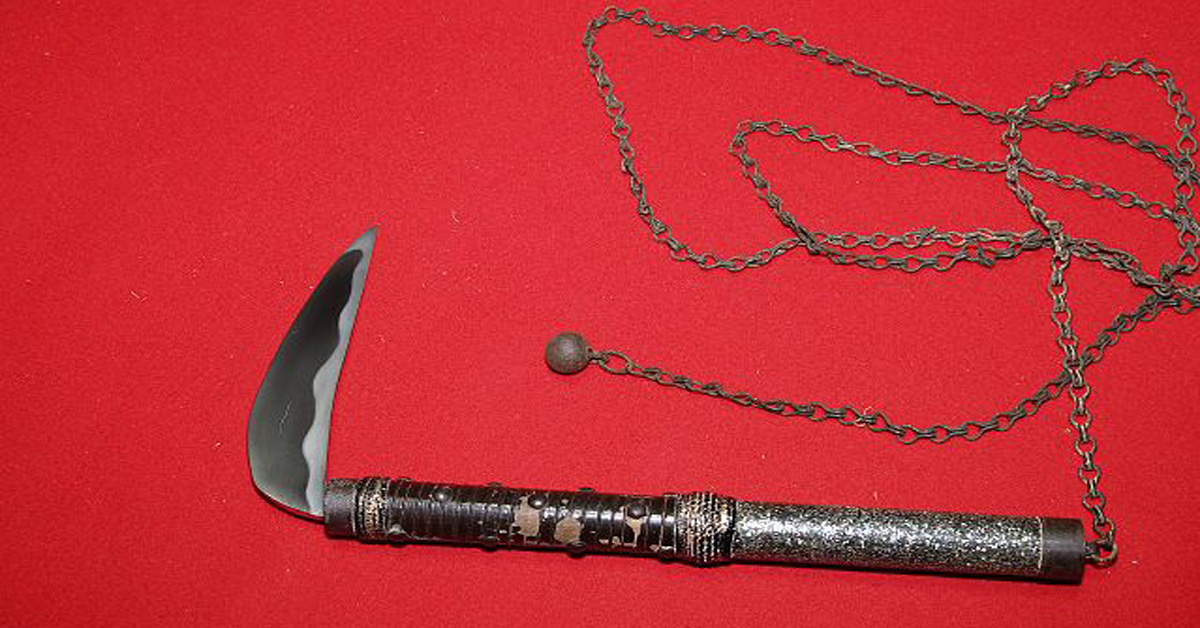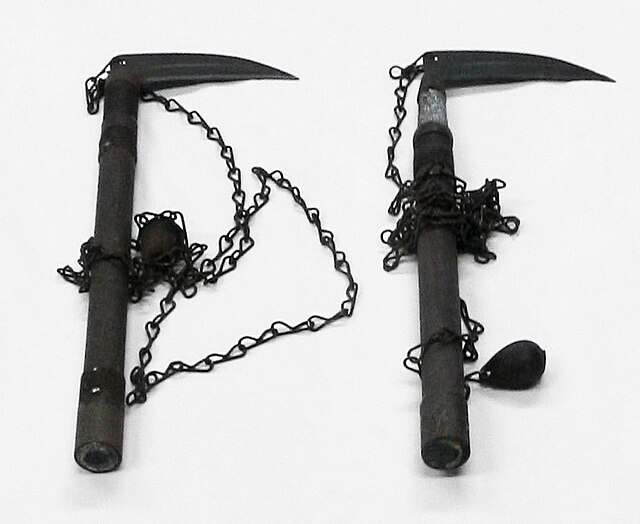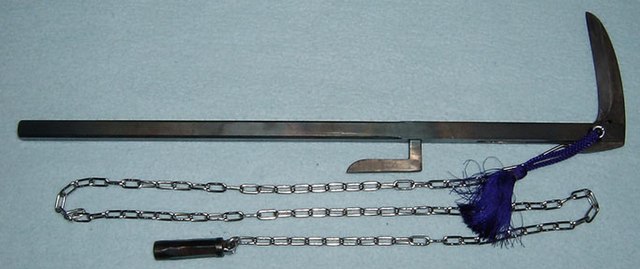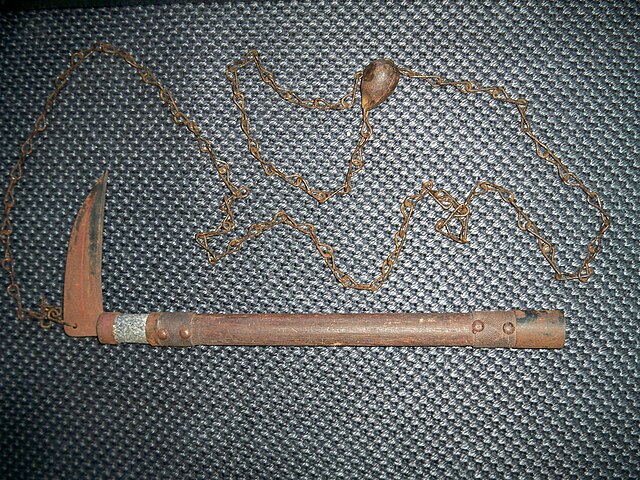Kusarigama: Japanese Weapon

The kusarigama is one of the most popular Japanese weapons in history. Ninjas popularized this effective weapon that has an incredible history.
Here’s everything you need to know about the kusarigama. Find out how the kusarigama was created, how it was used, and the various techniques you execute with it.
What is a Kusarigama?
A kusarigama is a traditional Japanese weapon with centuries of history. The weapon comprises a kama sickle connected to a heavy-weighted ball by a chain.
Kusarigama, translated into English, means “chain-sickle,” which is exactly what the weapon is. It is a highly versatile weapon with centuries of history and is still practiced in Japanese martial artists.

What are the Parts of a Kusarigama
As previously mentioned, the kusarigama is made up of 3 parts.
- Kama (Sickle)
- Kusari (Metal Chain)
- Fundo (Heavy Iron)
The History of Kusarigama
The history of the kusarigama is said to be traced back to the Muromachi period (also called the Ashikaga period). Historians generally agree that the kusarigama was adapted from a basic farm tool called a “jingama.”
The jingama was a type of sickle or kama used for various work on Japanese farms. Many farmers would connect their kama to a chain and weighted iron around their wrists.
These farmers adapted this weapon for convenience and self-defense purposes. They could easily keep hold of the weapon and attack any thieves attempting to steal their horses.
This weapon was never used in open warfare but mainly for one-on-one confrontations. During the weapons ban in Okinawa, many Okinawans adapted types of kusarigamas to defend themselves.
As new weapons like the kusarigama were innovated, assassins and spies called “ninjas” popularly used them.
Kusarigamas were also used seemingly as toys for soldiers. Many samurai or soldiers practiced using the kusarigamas and other weapons on their off time.
The weapon was commonly taught at Japanese Jujutsu academies. Later in history, martial arts schools would teach the kusarigama around the world thanks popularity of martial arts action films.
This led to a resurgence in the popularity of Chinese and Japanese weapons, like the kusarigama. Today, we commonly see the weapon used in action movies and video games.

The Legend of the Kusarigama
There is a much cooler tale about how the kusarigama was developed. Legend has it that a Japanese peasant farmer used his kama/chain to defeat an attacking samurai. This led the kusarigama to become a commonly practiced weapon that could defeat samurai.
Of course, this is just a story, as there is no historical evidence of a Japanese farmer beating a samurai. It’s just a story to make people want to learn how to use a kusarigama.
Types of Kusarigama
Different types of kusarigama exist, and they can vary in terms of design, size, and purpose. Here are five common variations of the kusarigama.
- Short Kusarigama: A smaller variation of the Japanese weapon made for close-range combat, which includes a shorter chain.
- Long Kusarigama: The bigger version of the weapon, which allows for attacks from a longer range.
- Weighted Kusarigama: The classic version of the kusarigama that is versatile and has a range of attacks from different distances.
- Unweighted Kusarigama: The unweighted version
Training Kusarigama:
Kusarigama Techniques
The kusarigama is arguably the most versatile Japanese weapon used by ninjas. Here are the many techniques included in kusarigama training.
- Kama Strikes
- Chain Strikes
- Chain Entanglements
- Throwing Techniques
- Defensive Techniques
- Grappling & Binding Techniques
- Disarming Techniques
- Joint Locks
- Trapping Techniques
- Strangulation
- Feinting & Misdirection
- Stance/Footwork
- Combination Techniques
- Escapes & Counters
Kama Strikes
The main and most deadly strikes of the kusarigama are the common strikes. A kama delivers slicing movements from every angle.
Chain Strikes Chain
Chain strikes are a must-know when wielding a kusarigama. Being a close-range weapon, the use of the chain is usually one of the first moves used. Striking an enemy with the weighted side to concuss them and open up a finishing strike with the kama.
Entanglements
Learning to wrap the chain around your opponent and their weapons is common in close-range fighting. Practitioners learn how to entangle an enemy with the chain to disarm and disable them.
Throwing Techniques
The kusarigama is commonly practiced by Japanese Jujutsu practitioners, who developed throws using the weapon. Off of the entanglements, practitioners can throw their enemies to the ground and finish them.
Defensive Techniques
The kusarigama is mainly a defensive and counter weapon. A majority of the attacks learned are counters off basic defensive techniques.
Grappling & Binding Techniques
Along with the entanglement techniques, practitioners of the weapon also learn grappling and binding techniques.
Disarming Techniques
Since the kusarigama is predominantly a counter-attack weapon, many disarming techniques are taught. This includes how to disarm any type of weapon, from a sword, knife, spear, or staff.
Joint Locks
Many practitioners of this weapon are also usually grapplers, many joint locks have been developed using the kusarigama.
Trapping Techniques
Another type of entanglements taught are called trapping techniques. Using the chain and kama, the practitioner traps their enemy and enters an entanglement.
Strangulation
Obviously, since a chain is part of this weapon, there are many kusarigama strangulation techniques that practitioners learn.
Feinting & Misdirection
Feinting and misdirection techniques are important components of kusarigama training. This weapon. It is not a straight-up attack weapon but a weapon whose techniques must be hidden.
Stance & Footwork
Stance and footwork are the first things beginners learn when they begin practicing with this weapon.
Combination Techniques
Once a practitioner understands the previous techniques, they combine them into drills. Learning how to flow through their attack combinations.
Escapes & Counters
As a counter-attack weapon, escape and counter techniques are vital when learning to wield a kusarigama.

Kusarigama Training
There are two types of kusarigama training: competition and self-defense training. Both styles of training teach the same techniques but use different methods.
Modern kusarigama training is mostly practiced by martial artists who compete in weapons kata/patterns competitions. These practitioners don’t practice sparring or partner drilling but rather just the movements to create their routine.
Self-defense style kusarigama training is more realistic and consists of drilling and sparring. In training for both training styles, wooden or bladeless kusarigamas are used.
Kusarigama in Pop Culture
Since the 1970s and 1980s, we have seen depictions of the kusarigama being used in different places in pop culture. Many movies and video games, like the Ninja Gaiden series, have characters using the kusarigama.
Is the Kusarigama an Effective Weapon?
The kusarigama is an effective weapon with centuries of history and use. If you’re martial arts school has kusarigama classes available, it would benefit your self-defense to learn techniques for this weapon.






